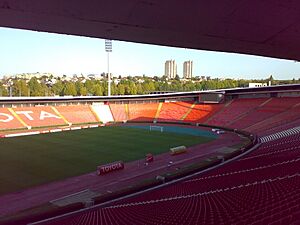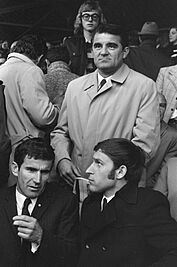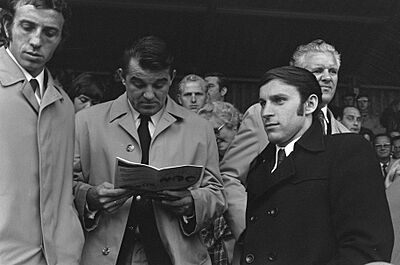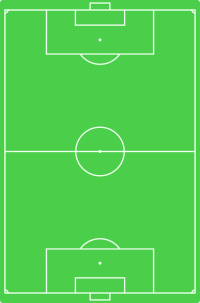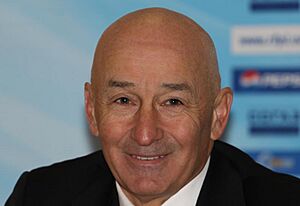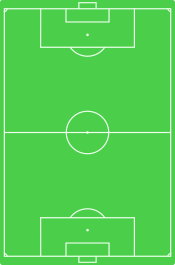History of Red Star Belgrade facts for kids
The history of Red Star Belgrade's football team started when it was created by a group of Yugoslav Communists on 4 March 1945. Slobodan Penezić led the group that founded Red Star. Many of them were veterans from World War II. This was different from Partizan, which was founded by high-ranking army generals.
Contents
- The Story of Red Star Belgrade
- How Red Star Began (1945–1951)
- The Golden Years of the 1950s (1952–1958)
- New Stadium and New Challenges (1958–1966)
- The Miljanić Era: European Success (1966–1975)
- Keeping Strong: First European Final (1976–1986)
- European and World Champions! (1986–1991)
- Tough Times in the 1990s (1992–2000)
- A New Century (1999–2004)
- After Yugoslavia (2004–2009)
- Challenges and Recovery (2009–2015)
- Getting Stronger and Back to Europe (2017–Present)
- See also
The Story of Red Star Belgrade
How Red Star Began (1945–1951)
In February 1945, during World War II, some young members of the Serbian United Antifascist Youth League decided to form a sports club. This club became Red Star Belgrade on March 4. After the war, many old Yugoslav clubs were closed. This was because they had played matches during the war. The new communist government called them "collaborators."
Two of these clubs were SK Jugoslavija and BSK Belgrade. Red Star was formed from what was left of Jugoslavija. They even got Jugoslavija's stadium, offices, players, and their red and white colors.
The name "Red Star" was chosen after a long talk. The first vice presidents, Zoran Žujović and Slobodan Ćosić, picked it. Ćosić asked, "Should we call our club the Star?" Žujović quickly replied, "Great, if it's the Star, let it be Red Star!" Everyone agreed. Red Star soon became a symbol of Serbia. It is still the country's most popular sports club today.
On that first day, Red Star played its very first football match. They won 3–0 against a team from the People's Defence Corps of Yugoslavia. Five days later, a football section was formed. It was led by Kosta Tomašević and Predrag Đajić. Tomašević was the first striker and goal scorer for the club. He also scored Red Star's first European goal in 1956. Đajić was a strong midfielder.
In 1946, Red Star won the Serbian Championship. This meant they moved up to the top league, the Yugoslav First League. In their first few seasons, they finished third and second twice. From 1948 to 1950, Red Star won the Yugoslav Cup three times in a row. They beat rivals like Partizan and Dinamo Zagreb in the finals.
Red Star won its first League championship in an amazing way. With three games left, Dinamo Zagreb was five points ahead. But Dinamo lost a game, and Red Star won a big match against them. This meant Red Star was only one point behind before the last game. Dinamo drew their last match 2–2. The championship was decided a day later, on November 4, in a match against Partizan. Red Star had lost to Partizan 6–1 earlier that season. But this time, Red Star won 2–0. Thanks to a slightly better goal difference, they became the champions of Yugoslavia for the first time!
The Golden Years of the 1950s (1952–1958)
Red Star won the championship again in 1953. But the real changes happened in the mid-1950s. The club got a strong leadership team. Dušan Blagojević became president, Slobodan Ćosić was secretary general, and Aca Obradović, known as Doctor O, was the technical director.
They helped create a team that would dominate Yugoslav and European football for five years. This team included legendary players like Beara, Durković, Stanković, Popović, Mitić, Kostić, and Šekularac. These famous players won four Yugoslav championships and two Cups. They won every Yugoslav trophy for five seasons in a row!
Red Star played fast and attacking football. This made them very popular in Yugoslavia and around the world. While they were winning on the field, Obradović set up a professional system. This system helped the club achieve many successes later on.
In 1956, Red Star won the championship. They also reached the semi-finals of the 1956–57 European Cup. They played against Fiorentina from Italy. Red Star striker Kostić had scored five goals in their European Cup games so far. But Red Star couldn't score against Fiorentina, and the Italian team went to the final.
As champions, Red Star entered the 1957–58 European Cup. They famously lost 5–4 on total score to English champions Manchester United in the quarter-finals. Manchester United, led by Matt Busby, won the first game in England 2–1. The return game in Yugoslavia on February 5 ended in a 3–3 draw. This second game was the last one played by the famous "Busby Babes" team. The next day, on their flight back to England, the plane crashed in Munich, West Germany. This terrible accident killed 23 people, including eight Manchester United players.
In 1958, Red Star also won its first European trophy, the Mitropa Cup. They won this cup without losing a single game.
New Stadium and New Challenges (1958–1966)
The late 1950s were a time when Red Star was the best club in Yugoslav football. But by the early 1960s, things changed. Their rival, Partizan, became stronger. In the next seven seasons, Red Star won only one championship and one cup. This was not enough for a club as big as Red Star. They even had their worst league finishes ever, including seventh place in 1963.
Red Star often finished outside the top three during this time. Before and after this period, Red Star never finished below third place in 54 seasons in Yugoslavia and Serbia. Even then, Red Star was by far the most popular club in the country. Their losses made their fans very upset. Sometimes, Red Star fans would even run onto the field and burn the goalposts! In the 1963 season, the team scored only 21 goals. This was half of what Vojvodina scored, even though Vojvodina finished five places lower.
However, Red Star did well in international competitions. In the 1961–62 Inter-Cities Fairs Cup, Red Star beat Espanyol in the quarter-finals. In the semi-finals, they played against F.C. Barcelona. Barcelona was better in both matches, and Red Star was knocked out. But only eight months later, Red Star beat the Catalan club in the same competition. Still, even a 2–0 win against A.S. Roma was not enough for Red Star to move forward.
While having mixed results on the field, Red Star continued to grow. Construction of a new stadium began in Belgrade at the end of 1959. For the next four years, Red Star played their home games at Partizan's stadium and OFK Belgrade's stadium. This might have been one reason for their struggles during this time.
The new stadium opened in 1963. Red Star played against NK Rijeka in the first match. Over time, the sold-out Red Star Stadium became known as "the Marakana." This was after the famous Maracanã stadium in Brazil. The stadium became known as a very tough place for visiting teams to play. In the stadium's first season, Red Star won both the league and the cup. Milorad Pavić was their coach.
A key moment happened in 1966 when Miljan Miljanić became the club's coach. For the next eight years, Miljanić turned Red Star into a highly respected European team. Yugoslav football had gone through its early stages, and Red Star and Partizan continued to be the top teams. For the remaining 25 years of Yugoslavia's existence, Red Star would always be a favorite to win trophies.
In 1968, Red Star won its second Mitropa Cup. After winning, Red Star stopped playing in the Mitropa Cup. They wanted to focus more on other European competitions.
The Miljanić Era: European Success (1966–1975)
Miljan Miljanić had played a few games for Red Star in the early 1950s. But he found real success when he became a coach in the summer of 1966. In his first season as head coach, Miljanić completely changed the team. They finished fifth in the league, the same as the year before.
The next season, a new generation of players started to make a big impact. This team was led by 21-year-old Dragan Džajić. He became a famous footballer, voted the best Serbian player ever. He is considered one of the best left wingers in the world.
With players like Ratomir Dujković, Milovan Đorić, Kiril Dojčinovski, Stanislav Karasi, Jovan Aćimović, Vojin Lazarević, Petar Krivokuća, Stevan Ostojić, and Branko Klenkovski, Red Star achieved something special. From 1967 to 1970, they won three league titles in a row. They also won the league and cup double twice. At the same time, Red Star became a strong and consistent team in Europe.
In 1971, Red Star focused on winning the Yugoslav Cup. This led to their second-worst league finish ever, sixth place. However, they did win the cup. Red Star also won two Supercups in 1969 and 1971. Besides the cup victory, Red Star reached the semi-finals of the 1970–71 European Cup. They were knocked out by Greek team Panathinaikos. In the first match, Red Star beat the Greeks 4–1 in Belgrade in front of 100,000 fans. They seemed to be in a strong position. But they lost 3–0 in Athens, losing on away goals and missing the final again.
Miljanić won another Yugoslav Cup with the team in 1973. New players like Vladimir and Ognjen Petrović, Bogićević, Filipović, Janković, and Keri joined the team.
During Miljanić's eight years as coach, Red Star was the top-scoring club in Yugoslavia seven times. In his last two seasons, Red Star won the league title by huge margins. They were 12 points ahead one year and 18 points ahead the next.
In the 1973–74 European Cup, Red Star knocked out Liverpool, who were the champions at the time. By beating Liverpool, Red Star became only the second foreign team to win against Liverpool at Anfield. They were also the only team to beat Liverpool at home in the European Cup in the entire 20th century. However, Red Star lost their next quarter-final match against Atlético Madrid 2–0 on total score.
The next season, in 1975, Red Star played against Real Madrid. The newspapers called it the Džajić vs. Camacho game. This was because Dragan Džajić was the best left winger in the world, and Camacho was one of the best defenders. In the first game, Red Star played at the Santiago Bernabeu. Their former coach Miljan Miljanić was now coaching Real. Red Star lost 2–0 in front of 125,000 fans.
In Belgrade, Red Star managed to tie the score on total goals in front of 100,000 fans. Goals from Džajić and goalkeeper Petrović made it 2–0. Red Star then won 6–5 in a penalty shootout. This was their first time reaching the semi-finals of the European Cup Winners' Cup. There, they played against Ferencváros from Budapest. Red Star lost the first game 2–1. The return game is remembered for having the biggest crowd ever at Red Star Stadium. Although 96,070 tickets were sold, it's believed about 110,000 people were there. Everyone went home disappointed. A penalty kick in the 83rd minute made the score 2–2, sending Ferencváros to the final.
Keeping Strong: First European Final (1976–1986)
When a great coach leaves, results often drop. The two seasons after Miljanić left were less successful for Red Star. It wasn't until Gojko Zec arrived in 1976 that the club became stable again. Soon, Red Star celebrated winning the national championship at the Marakana. This led to the era of Branko Stanković, who coached for four years. He brought Red Star three trophies and their first big European final.
After Dragan Džajić moved to another club, the team was led by the "fourth star" of Red Star Belgrade, Vladimir Petrović "Pižon," Dušan Savić "Dule," and Srboljub Stamenković. Stamenković later became a big football star in the United States.
The first season with Gojko Zec was a show of strength. They won the league by nine points, which was the biggest lead in the league's history at that time. Red Star's strikers, led by Zoran Filipović, scored 67 goals.
The next season, Red Star finished second in the league. This set the stage for a great performance in the 1978–1979 UEFA Cup. After beating teams like Arsenal, West Bromwich, and Hertha BSC, Red Star reached the Cup final for the first time. There, Red Star met Borussia Mönchengladbach, a German team that had played in five European finals between 1973 and 1980.
In the first game, about 100,000 excited fans watched. Red Star scored first with a goal from Miloš Šestić. But a goal from Jurišić gave Gladbach a mental advantage before the second game. The second game was played in Düsseldorf, Germany. The Italian referee gave a questionable penalty to the Germans, and Danish player Allan Simonsen scored. The Foals won 2–1 on total score.
Stanković won his first championship as a coach in 1980. Red Star missed winning both the league and cup that year. A year later, Red Star was champion again. Their longest period without winning the cup (eleven years) ended in spring 1982. Red Star beat Dinamo Zagreb 6–4 on total score. During this time, Stevan Ostojić replaced Stanković as coach. Red Star reached the quarter-finals of the European Cup twice. In 1981, Inter Milan eliminated them. In 1982, RSC Anderlecht knocked them out.
Then came historical matches against Udo Lattek's Barcelona in the 1982–83 European Cup Winners' Cup. Barcelona was the better team in both matches, and Red Star was eliminated. What was amazing was when Barcelona's Maradona scored his second goal in front of about 100,000 fans at Marakana. The Belgrade crowd was so excited by the goal that even the loyal Red Star fans applauded Maradona, which was unheard of.
Gojko Zec returned to coach the team in 1983. He found only one player from the championship team he coached in 1977: Miloš Šestić. Zec repeated his earlier success by winning the championship right away. And just like before, the cup final was played in Split, where Red Star again beat Dinamo Zagreb to lift the cup trophy.
Especially after Petrović and Savić left in 1982/83, Šestić became the leader of a new generation. This included players like Ivković, Elsner, Boško and Milko Đurovski, Musemić, Milovanović, Janjanin, and Mrkela. Bringing in experienced players from all over Yugoslavia proved to be a recipe for success.
The end of Gojko Zec's time as coach happened at the same time as a big scandal in Yugoslav football, known as the Scheiber’s case. This led to the country having two champions in two seasons. Red Star first lost and then won the championship in 1986. But then it was taken away from them due to the scandal. However, in 1986, Red Star also reached the quarter-finals of the European Cup Winners' Cup, but lost against Atlético Madrid.
European and World Champions! (1986–1991)
In 1986, big changes happened at the club. The club's leaders, Dragan Džajić and Vladimir Cvetković, started to build a team that could compete with the strongest teams in Europe. That summer, Velibor Vasović became coach. The team got stronger by bringing in many talented young players. Among them, Dragan Stojković and Borislav Cvetković stood out.
In the first season, Red Star focused on the European Cup and getting good results. In 1987, the club made a five-year plan. The only goal was to win the European Cup. Everything they planned was finally achieved. On the club's birthday in 1987, it all began. Real Madrid was defeated at Marakana.
From that day until March 1992, Red Star had the best period of success in its history. In these five seasons, Red Star won four national championships. (In 1989, Vojvodina won the championship). At the end of the 1989/90 season, Red Star finished 11 points ahead of all other teams. A year later, they finished eight points ahead. Both times, Dinamo Zagreb was their closest rival.
In all four seasons Red Star won the championships, they also played in the finals of the National Cup. However, they won the Cup only in 1990. It might seem strange that Red Star had five different coaches during these amazing five years (Vasović, Stanković, Šekularac, Petrović, and Popović). But this shows how strong the "red-whites" were, both in their management and on the field.
In 1987, Binić and Prosinečki joined Red Star. Then came Šabanadžović, Pančev, Savićević, Belodedici, and Mihajlović. From the youth academy, Stojanović and Jugović joined the first team.
At the very beginning of the 1990s, Red Star, powered by Pančev's goals, easily won domestic competitions. In Europe, they were among the very best. They won the 1991 European Cup without losing a single game in Bari. Then they won the 1991 Intercontinental Cup in Tokyo.
After this, the Yugoslav wars began. Yugoslavia started to break apart, and the UN placed sanctions on FR Yugoslavia. This quickly led to Red Star losing almost all of its European and World champion players. It left a big question: how many more titles would this amazing generation have won?
The Road to Bari (1990–1991)
The years leading up to 1991 were arguably the most important and successful in Red Star Belgrade's history. During this time, the club won its first European Cup and Intercontinental Cup.
Building a European Giant
Since the mid-1980s, plans to win the European Cup were made at Marakana. In the past, Red Star had achieved good European results by using its youth players and bringing in top talented footballers from other Yugoslav clubs. The new Red Star management, led by Dragan Džajić, decided to try a different approach. They chose to pick the best Yugoslav players to create a team that could immediately compete at a high level in Europe. They wanted to become a candidate for the European trophy.
In 1986, the first step in this new direction was taken. They brought in Borislav Cvetković, Milivoj Bračun, and Slobodan Marović. They also brought in one of the greatest Yugoslav football players ever, Dragan Stojković "Piksi" from Radnički Niš. Only a year later, "Piksi" was followed by Dragiša Binić. Binić later formed one of the fastest attacking pairs in Europe with Cvetković. Goalkeeper Stevan Stojanović, who came through Red Star's youth ranks, also joined.
In 1987, the first big challenge arrived in Belgrade. Spanish giant Real Madrid, with stars like Hugo Sánchez and Emilio Butragueño, was defeated at the Marakana by 4–2 in the quarter-finals of the 1986–87 European Cup. But "the Royals" knocked Red Star out on away goals (Real had won 2–0 in Madrid).
Red Star continued to build its "Dream Team." Dinamo Zagreb lost its most gifted player, Robert Prosinečki. He later won the 1987 FIFA World Youth Championship with Yugoslavia and was named the tournament's best player. Then came Refik Šabanadžović, a new Yugoslav national team defender. In 1988, Dejan Savićević and Darko Pančev, the best remaining players in the league, signed for the "Red & Whites." The talented Ilija Najdoski also joined.
How ready Red Star was for great achievements was shown the next season. In 1988, Marakana welcomed a new super match. In the 1988–89 European Cup season, Red Star played against Arrigo Sacchi's A.C. Milan. Milan had its Dutch European champions trio: Gullit, van Basten, and Rijkaard. These were absolute superstars at the time. Milan also had defensive stars like Baresi, Maldini, Costacurta, and Tassotti. Milan was the absolute power in football then and the biggest challenge for Red Star.
At San Siro, Red Star shocked Milan with a goal from Stojković and earned a well-deserved 1–1 draw. Many Milan fans worried about being knocked out of Europe. In the "hell" of Belgrade, Milan was in trouble when Savićević put Red Star ahead in front of 100,000 fanatical Red Star fans. Luckily for Milan, the game was stopped in the 64th minute by the referee because of thick fog. The visibility was so bad that the match couldn't continue that day. The match was then cancelled, and the game was replayed the next day. Striker van Basten gave Milan a first-half lead. But Stojković equalized soon after, and there were no more goals. Milan won the penalty shootout 4–2 and went on to win the European Cup.
The Circle Closes
Even though coaches changed each year, Red Star kept a playing style based on quick strikers and top-quality midfielders. In 1989, Red Star lost the league title to Vojvodina from Novi Sad. This had a huge impact on their future games. Because of this, another attempt to win the European trophy was focused on the UEFA Cup.
In 1989, after beating Galatasaray and Žalgiris, came a crucial day on Red Star's journey to Bari. Šekularac's team was badly defeated and knocked out in the third round of the UEFA Cup against 1.FC Köln. This taught them a hard lesson in competitive football. In Belgrade, Red Star won 2–0 in front of 100,000 fans with two goals from Savićević. But they lost 3–0 in Cologne, even though Red Star controlled the game for an hour.
Pieces of the puzzle continued to fit with former European Cup winner Miodrag Belodedici. In 1988, when Ceauşescu was still in power, Belodedici left Romania for Yugoslavia. Red Star immediately signed him. Romanian authorities claimed his player contract was fake, and UEFA suspended him. In 1989, Belodedici was finally allowed to play for Red Star.
In 1990, Šekularac was replaced by Ljupko Petrović. Petrović was the man who had taken the title away from Red Star just a year before with Vojvodina. He brought Red Star's talented young player Vladimir Jugović to the first team. Soon, Mihajlović also joined from rivals Vojvodina.
The club was weakened by the departure of captain Stojković. He was undoubtedly one of the best players in the world that year, as he showed at the 1990 FIFA World Cup. Stojković left Red Star for Marseille, not knowing he wouldn't see his teammates again until next May. Even without a captain, Red Star remained extremely strong and had good players in every position. Red Star easily won the championship, and it was time for this carefully built team to prove itself at the highest level. This was happening even though the political situation at the time was difficult.
The Grasshopper Blues
|
|
| Jersey worn by Red Star during the 1990/91 season |
In the first round of the 1990–91 European Cup, Red Star Belgrade was drawn against Grasshoppers from Zürich, Switzerland. The Swiss club, led by coach Hitzfeld, scored first with Közle, shocking the Marakana crowd. Binić, who had returned to Red Star that summer, managed to equalize. With the score at 1-1, Red Star had a tough start. But the return match at Hardturm stadium showed the true abilities of Petrović's team.
Prosinečki, who won the Best Young Player Award at the 1990 FIFA World Cup, started a scoring spree in the European Cup by scoring twice. Pančev and Duško Radinović added two more goals. Another goal by Közle didn't matter. Red Star defeated Grasshopper Zürich overwhelmingly 5–2 on total score.
The second round brought a real spectacle to Red Star Stadium. Scottish record-winner Rangers visited Belgrade. The "Blues" wanted a good result that day. However, the overcrowded Marakana, with its supporters, the Delije, inspired Red Star players to play another magnificent match. Chances came one after another. Within minutes, an own goal by Brown and a free kick from Prosinečki doubled Red Star's lead. Finally, Pančev scored to make it 3-0, leading to a huge celebration. During the return match at Ibrox Park, Pančev scored again with an attractive bicycle kick. The legendary McCoist could only equalize. Red Star showed their power, and the 1–1 draw in Glasgow gave Red Star a 4-1 total victory.
German Tour: From Dresden to Munich
Red Star continued their impressive form into the quarter-finals. The club began a "German tour." They were strengthened by Siniša Mihajlović from reigning Yugoslav champion Vojvodina. He was bought for a lot of money at that time. Their opponent was the last East Germany champion, Dynamo Dresden. The match was highly anticipated. At the "hell" Marakana, the scene was the same as against Glasgow. The rival was overwhelmed in front of an incredible 100,000 Red Star fans (with another 20,000 outside the stadium). Red Star won 3-0. Prosinečki scored from a free kick again, and Binić and Savićević scored the other goals. The atmosphere that day was one of the best in Red Star's history.
The Dresden match in Germany started badly for Red Star. The East Germans scored after only three minutes with Gütschow. However, Red Star's better quality was soon clear. Savićević and Pančev managed to turn the score around. The match was stopped in the 78th minute by the referee because Dynamo Dresden fans caused trouble in the stands and threw objects onto the field. UEFA awarded a 3–0 win to Red Star, making it 6–0 on total score. Red Star reached the European Cup semi-final for the third time in history. There, they met FC Bayern Munich with its World champions.
Although Red Star had lost to Bayern twice a decade earlier, the club was full of optimism. Red Star legend and director Džajić even predicted a victory in Munich. Wohlfahrt's goal gave Bayern a temporary lead. But Red Star took control at Olympic stadium and fought back. Just before halftime, Prosinečki passed to Binić. Binić made a quick run and crossed the ball to the far post. Pančev received the ball and scored, making it 1-1.
Then, after 70 minutes, the Red Star defense stopped a Bayern attack. Pančev perfectly passed to Savićević, who ran from the center to the penalty area. He was unstoppable for Kohler and Aumann. The score became 1-2, and about 15,000 Red Star fans on the north stand celebrated the victory. It was remarkable that Red Star was the first team to beat Bayern at the Olympic Stadium in its long UEFA competition history. This was just the beginning of their path to the trophy.
Bayern was welcomed by the Delije with a historical flare show around the entire Red Star Stadium. But soon, Yugoslavia was on the edge of civil war. The first fighting of the war happened. Croat extremists fired missiles into Borovo Selo, a village on the border with Serbia, where Red Star midfielder Mihajlović grew up. And it was Mihajlović who increased Red Star's lead in Belgrade with a first-half free-kick, making it a two-goal advantage.
The tension began when Augenthaler's free-kick went through Stojanović's arms and legs. Five minutes later, Bender scored to make it 1-2. Bayern had equalized and wanted to score more. In the last 30 minutes, chances came one after another in front of both goals.
As the game entered its final seconds, Red Star attacked one last time. Then came the historical moment. Jugović carried the ball diagonally and played a quick one-two with Pančev. Prosinečki took the ball, passed through the left side of the field, and returned the ball to Mihajlović. Mihajlović sent a low cross into the penalty area. Bayern's Augenthaler stuck out a leg to intercept, but he only sent the ball high into the air. Pančev confused Aumann, and the ball looped over the goalkeeper's head and into the net!
The stadium exploded, and the amazing 100,000 Red Star fans were overjoyed. Red Star players and supporters went wild with delight because there was no time left for Bayern to come back. The final whistle sparked a huge celebration inside the stadium and a massive pitch invasion. The 4-3 total win brought Red Star, after two semi-finals, their first European Cup final in history. Olympique de Marseille was waiting for them.
European Star
The 1991 European Cup Final was played in Bari, Italy. Red Star coach Petrović brought the team to Italy a week before the final. He wanted the players to prepare calmly for the match against Olympique. At that time, Red Star had scored 18 goals in 8 matches, while the French champions had scored 20. So, the 100th European final was expected to be a goal-scoring spectacle.
However, both Petrović and Goethals chose to play defensively. The match became a tough battle. After 120 minutes of play and only a few chances for both sides, the winner was decided by a penalty shootout.
Prosinečki scored into Olmeta's net with a medium-high kick. Then, Stojanović saved Red Star's goal from Amoros’ kick by diving to the right. This save proved to be the most important moment of the game.
Then came the other goals in this order: Binić, Casoni, Belodedici, Papin, Mihajlović, and Mozer. The chance to win came to Darko Pančev, the winner of the European Golden Boot. He aimed near the center of the goal, kicked the ball, scored, and brought the European Cup to Yugoslavia for the first time!
Red Star won the shootout 5-3 on May 29, 1991, in front of 60,000 spectators and millions watching on television around the world. 20,000 Red Star fans at Stadio San Nicola and millions more across Yugoslavia and the world celebrated the greatest joy in Red Star's history. The night of the 1991 European Cup Final was one of the last times that Yugoslavia could celebrate as one.
Prepared in England, Made in Japan
As European champion, Red Star Belgrade played for the European Super Cup trophy. They also played for the Intercontinental Cup, which had been held for decades in Tokyo, Japan. At that time, the Super Cup usually had two matches. However, there was only one match against Manchester United, held at Old Trafford. This was because of the war that had already started in Yugoslavia. Even though Red Star Belgrade controlled most of the 1991 European Super Cup final, and Savićević played brilliantly, the only goal was scored by McClair for Manchester United.
In Tokyo, Red Star looked to finish the year with another international trophy. Their opponent was Chile's Colo Colo, the Copa Libertadores winner. On Colo Colo's bench was Mirko Jozić, who had coached Yugoslavia to become Youth World Champions. Prosinečki, who was the world's best player of his age, had left Red Star right after they won the European Champion title. He was sold for a lot of money to Real Madrid. Other key players like Stojanović, Marović, Šabanadžović, and Binić also left.
During the 1991 Intercontinental Cup final, Jugović, the youngest regular player of the club, scored two goals at National Stadium. His brilliant play earned him the Toyota prize for the best player of the match. Red Star was so much better than their opponent. Even after Savićević was sent off just before halftime, Red Star still won comfortably. At the time of the red card, Belgrade was already 1-0 up thanks to Jugović. He scored another goal, and Pančev added one more, bringing Red Star the final score of 3–0.
On December 8, 1991, Red Star had achieved everything a football club could. They were both the European Champion and the World Champion, at the height of their fame.
Tough Times in the 1990s (1992–2000)
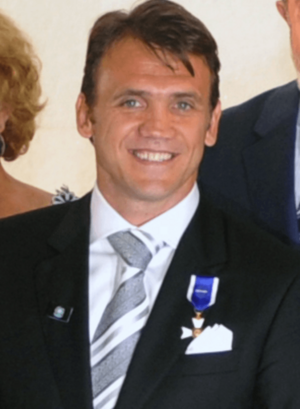
In 1992, the club became weaker as almost all the champion players left. New players like Drobnjak and Ivić joined later. Also, Red Star had to play their European matches outside of their country because of the war in former Yugoslavia. This made it harder for them to defend their title.
UEFA changed the format of the championship that year. Instead of a cup, they started the 1991–92 Champions League. Eight best teams from Europe played in it. On their way to the group stage, Red Star beat Portdown and Apollon Limassol. In their group, they faced Sampdoria, R.S.C. Anderlecht, and Panathinaikos.
It started with a 0–2 defeat against Sampdoria. This was their first loss after 17 matches, which was a very long unbeaten run in European competition. After that, they beat Anderlecht in Budapest and Panathinaikos in Athens and Sofia. The key game was against Sampdoria in Sofia. Red Star lost a 1–0 lead and were defeated 1–3. Sampdoria won the spot in the final. The end of a long era came in Brussels. Red Star lost 3–2 in a match that didn't matter for the competition. In 22 years, Red Star had reached the spring rounds in Europe 11 times and played 24 seasons in European competitions.
In domestic competitions, rival Dinamo Zagreb left the league, as did all other clubs from Croatia, Macedonia, and Slovenia. The championship in a smaller Yugoslavia was played under difficult conditions. In April, war broke out in Bosnia and Herzegovina. At the end of May, the UN placed sanctions on the country, removing Yugoslav football from the international scene. The idea that "politics has no place in sport" was ignored.
The breakup of Yugoslavia, the civil war (1992–1995), inflation, and UN sanctions hit Red Star hard. However, they defended their title and won the championship three times in a row for the second time (the first time was during Miljanić's era). But in the Cup finals, won by Partizan, it was clear that tough times were ahead for the club. A series of victories by Partizan followed.
Red Star won their 14th cup in 1995. This was thanks to another generation of great players. These included Dejan and Jovan Stanković, Kovačević, Ognjenović, Đorović, Stefanović, Sakić, Živković, Krupniković, Petković, Milojević, and Stojkovski. On their way to the title, they also won the legendary 100th Belgrade derby 2–1 in front of 80,000 spectators, with goals from Kovačević and Stojkovski. Petrović was coaching again.
Still, this was a short break during unsuccessful years. Under new and strange circumstances, it was hard for the club to find its way. As the 1990s ended, the 1998/99 championship was not finished due to the Kosovo War. Red Star finished in third place. This was the only time in 20 years they finished below second place in the league. Between May 1992 and May 2000, Red Star won only one championship. However, they did manage to win five cups, along with some great European performances.
Return to Europe: A Hard Journey (1995–1996)
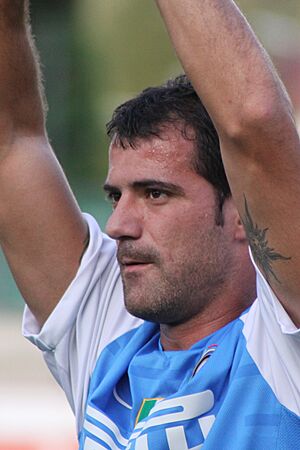
During the 1994/1995 season, UEFA and FIFA allowed Yugoslav football clubs back into competitions. The national team continued where they left off in spring 1992. But clubs had all their past results erased. They were treated as beginners in European competitions. This meant Red Star, the European Champion in 1991, was placed at the bottom of the list. Instead of a place in the Champions League (as the Champion of SR Yugoslavia in 1995), they were moved to the UEFA Cup.
This decision had very bad long-term effects for Red Star. Instead of getting an easier path to the Champions League group stage, they faced tougher opponents from the start. The competition began as early as July.
Their first international game was a friendly match against Olympiacos. Red Star won 4–1 at Marakana. A large flag with "Welcome Orthodox Brothers" was a friendly gesture to Greek fans and players. Since that match, a friendship has existed between these two clubs and their fans.
Red Star's first European competition match after returning was on August 8, 1995, against Swiss Xamax. 60,000 fans came to greet the new generation. Despite all the problems, they had big goals. But after missing many chances, they were punished by a last-minute goal. In the return match, there were no goals. So, Red Star's season ended in the first round, which had never happened before.
If the first season in Europe was shocking, the second was promising. Under new coach Vladimir Petrović and with new players like Stanković, Ognjenović, Njeguš, and Jevrić, Red Star started the 1996–97 UEFA Cup Winners' Cup well. They eliminated Hearts. After a small defeat in Kaiserslautern, came a night that ended with three goals for Red Star in extra time. The reward for the 4–0 victory was a match against F.C. Barcelona.
The Catalans, with stars like Ronaldo, Figo, and Stoichkov, were a very strong team. They proved this by winning the Cup. Red Star lost 3–1 in Barcelona, but they didn't give up. In Belgrade, Barça faced a very tough atmosphere. Red Star led with a goal from Jovičić, but Giovanni equalized, which was enough for Barcelona to advance. The atmosphere at Marakana was probably one of the best in recent years, with amazing fan displays and a panorama of Belgrade in the west stand.
A New Century (1999–2004)
The summer of 1999 was a new beginning for the club. Shortly after the NATO bombing of Yugoslavia ended, Red Star won the 1999 Cup final with a 4–2 victory over Partizan. After four matches into the 1999–2000 season, coach Miloljub Ostojić was replaced by Slavoljub Muslin. By the end of the first half of the season, Red Star was in third place.
Red Star went on to finish the season in first place. They had a record of 33 wins, 6 ties, and 1 loss. Goran Bunjevčević was captain, and Mihajlo Pjanović was the team's top scorer. He was also the second highest goalscorer in the league. Red Star also won the 2000 Cup.
That summer, Red Star Belgrade entered the new Champions League qualification rounds for the first time. In the third qualifying round of the 2000–01 UEFA Champions League, Dynamo Kyiv eliminated Red Star on away goals. Red Star then went to the 2000–01 UEFA Cup first round, where they played Leicester City. They tied 1–1 in the first game.
UEFA decided that the second game, planned for September 21, 2000, would not be played in Belgrade. They did not approve of Red Star's guarantees for the safety of the visiting team. The match was supposed to happen three days before the election in Yugoslavia, which led to the overthrow of Slobodan Milošević. Red Star ended up beating Leicester 3–1 in the second game, which was held in Vienna. Tensions were high, and some Red Star fans behaved badly towards Leicester players. Red Star was then eliminated by Celta de Vigo in the second round.
Another try followed during the 2001–02 UEFA Champions League. They played against Bayer from Leverkusen (0-0 and 0–3 away), who later reached the final. Muslin left as coach in September 2001. After that, Red Star lost two league titles in a row. Another memorable match in this period was the 1–1 draw against Lazio at Marakana during the 2002–03 UEFA Cup.
On December 22, 2001, Red Star and the Yugoslavia national football team tragically lost a former player and a fan favorite, Jovan Gojković. He played for Red Star from 1997 to 2000. He died in a car crash in Belgrade at only 26 years old.
The return of Muslin as coach in 2003 brought back strong leadership to Red Star. During this season, the club set a new record. They conceded only 13 goals in 30 matches and finally won the title. Many players helped achieve these successes. Some of them were Vidić, Ačimovič, Bunjevčević, Žigić, Bošković, Vitakić, Drulić, Kocić, Marković, Pjanović, Dišljenković, Dudić, Kovačević, Krivokapić, Perović, Mladenović, and Milovanović.
After Yugoslavia (2004–2009)
| Red Star's starting team under coach Walter Zenga in their 3-1 UEFA Cup home match victory against Roma on 1 December 2005. |
After the breakup of FR Yugoslavia, Red Star had five different club presidents between 2004 and 2009. This caused some ups and downs in Red Star's seasons. With Ljupko Petrović as coach for the third time, Red Star finished first in the domestic league at the end of the 2003-2004 season.
The 2004–05 season brought instability to Red Star. President Dragan Džajić resigned on October 1, 2004. The Delije (Red Star fans) showed their support for Džajić. Red Star finished second in the league behind Partizan and lost the 2005 Cup final in an upset to Železnik.
On July 6, 2005, Red Star's assembly voted for Dragan Stojković to become the new club president. On July 22, 2005, Walter Zenga was chosen as Red Star's first ever foreign coach. In just one season, Zenga made a positive impact at Red Star. He coached them in their 2005–06 UEFA Cup campaign. Red Star played in Group E with Strasbourg, Roma, Basel, and Tromsø. Although they didn't make it past the group stage, Red Star beat Roma 3–1 on December 1, 2005, with two goals by Nikola Žigić. In the last season before Montenegro became independent in 2006, Red Star finished first in the league.
Zenga left in May 2006. His successor, Dušan Bajević, coached the team for most of the 2006–07 season. This was the first season where only clubs from Serbia competed. Bajević's first big test as Red Star coach was tough. In the third qualifying round of the 2006–07 UEFA Champions League, Red Star had the bad luck of drawing A.C. Milan. Milan went on to win the Champions League that season. Milan won 1–0 at San Siro and later 2–1 at Red Star Stadium. Both games felt like the legendary matches from the late 1980s.
On March 10, 2007, Red Star lost 0–3 at home to Vojvodina. After the Delije chanted "Dušan must go," Bajević famously left the field even though the match wasn't over. Red Star still finished first at the end of that season. Boško Gjurovski was chosen as Bajević's replacement. But after Red Star lost against Levadia in a second qualifying round match on August 8, 2007, the club administration pressured him to leave after only five months.
Gjurovski was replaced by Milorad Kosanović, who had last coached Red Star in 1998. Kosanović coached the team in the 2007–08 UEFA Cup. Red Star was drawn into Group F with Bayern Munich, Braga, Bolton Wanderers, and Aris. Less than two weeks before the group stage began, Dragan Stojković resigned as club president. He was replaced by Toplica Spasojević on November 20, 2007.
In their first group stage match, Red Star lost against Bayern 2–3 at home. Two goals for Bayern were scored by a 17-year-old Toni Kroos. This game set the tone for the rest of the UEFA Cup campaign. Kosanović resigned mid-season after Red Star lost to Aris 3–0 on November 8, 2007. Despite many coach changes, Red Star finished last in the group, losing every group stage match. Also, they failed to defend their title from the previous season. Red Star finished second behind Partizan in the domestic league at the end of the 2007–08 season. Red Star would not win the league again for another six years.
Challenges and Recovery (2009–2015)
In April 2009, Red Star saw several leaders come and go quickly. This was due to problems with how the club was run and its money situation. On April 23, 2009, Dan Tana resigned as president of Red Star. Less than a month later, the club's board voted for Vladan Lukić to be the new president.
On June 3, 2009, Vladimir "Pižon" Petrović was hired as Red Star's new coach for the 2009–10 season. Although Red Star started that season well, the autumn brought some controversy. In early 2010, Red Star's money problems were so bad that the club started accepting mobile-text donations. This fund was called "Za moju Zvezdu" (for my Star). A number for donations was put on Red Star's jersey where the main sponsor's name would normally be.
Despite the money problems, Red Star stayed in first place in the league for most of the 2009–10 season. They were still two points ahead of Partizan when Red Star's board decided to end Pižon's contract. They replaced him with Ratko Dostanić. This happened two days after Red Star lost 2–1 away to Metalac Gornji Milanovac. Red Star ended up losing their first-place position after the Eternal Derby on May 8, 2010. Partizan won 1–0 at their stadium. Red Star finished the 2009–10 season in second place.
On July 9, 2010, Red Star signed a five-year sponsorship deal with Gazprom Neft. One condition Gazprom insisted on was that 23% of the money for new player contracts had to go to Red Star's youth academy.
On December 19, 2012, Red Star assembly members voted for Džajić to be named president of Red Star again.
Red Star finished the 2013–14 season by winning their first domestic title in six years. But UEFA then banned them from playing in the 2014–15 UEFA Champions League qualifying rounds. This was because they broke UEFA's rules about club finances. The UEFA ban had huge consequences for Red Star's management and money situation. Less than two weeks after UEFA announced the ban, Džajić resigned as president.
After new elections on December 10–11, 2014, the committee of Red Star Belgrade named Svetozar Mijailović as the club president. Zvezdan Terzić was given a new role as general director. In the same meeting, the board officially named Red Star's stadium as Stadion Rajko Mitić.
Getting Stronger and Back to Europe (2017–Present)
On June 5, 2017, Red Star officially introduced Vladan Milojević as the new coach and Mitar Mrkela as the new sports director. That same summer, Red Star went through four qualifying rounds. They finally qualified for the 2017–18 UEFA Europa League group stage for the first time in ten years. In Group H, with Arsenal, 1. FC Köln, and BATE Borisov, Red Star finished second behind Arsenal. This meant they reached the knockout stage of a UEFA competition for the first time in 25 years. Red Star's 2018 Europa League journey ended in the Round of 32 after being eliminated by CSKA Moscow.
The next season, Red Star again survived four qualifying rounds. This time, they qualified for the 2018–19 UEFA Champions League group stage. In Group C, with Paris Saint-Germain, Liverpool, and Napoli, Red Star finished last. However, Red Star achieved a surprising 2-0 upset against Liverpool with two goals by Milan Pavkov. Liverpool went on to win the Champions League that season.
On May 5, 2019, Red Star beat Mladost Lučani 1–0. They won the league for the second consecutive season under coach Milojević. This was their 29th league title in club history. A few days later, the Football Association of Serbia officially recognized Red Star's title from the 1946 federal Serbian league. This league did not include teams from Vojvodina and was a second-tier championship at the time. As a result, Red Star's official number of domestic titles went from 29 to 30. A third star was then added above Red Star's badge.
After this, Red Star went through four qualifying rounds to qualify for the 2019–20 UEFA Champions League. They played in Group B with Bayern Munich, Tottenham Hotspur, and Olympiacos. Red Star finished last in the group.
Although Red Star continued to be the best team in the Serbian league, their 2019–20 season had some issues with referee decisions. On September 14, 2019, Red Star beat Inđija 2–1. But this happened only after two penalties were given to Red Star in the 88th and 90th minutes. The first penalty was a mistake by the referee, as the foul happened outside the penalty box. Mitar Mrkela admitted that the first penalty should not have been given. He stated that "Red Star supports the urgent use of VAR technology in our league."
See also
 In Spanish: Historia del Estrella Roja de Belgrado para niños
In Spanish: Historia del Estrella Roja de Belgrado para niños


